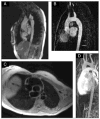The patient with Turner syndrome: puberty and medical management concerns
- PMID: 22884020
- PMCID: PMC3760009
- DOI: 10.1016/j.fertnstert.2012.07.1104
The patient with Turner syndrome: puberty and medical management concerns
Abstract
Turner syndrome (TS), which affects approximately 1 in 2,500 live-born females, is characterized by loss or structural anomalies of an X chromosome. Clinical features vary among patients; multiple organ systems can be affected. Endocrinologists are involved in the management of short stature, delayed puberty, and infertility. Endocrine therapies can include growth hormone, estrogen, and progestogen to promote linear growth and pubertal development. The duration of estrogen and progestogen treatment hormone treatment (HT) is generally more than 40 years. No one standard HT is suitable for all women, so general guidelines are provided to induce pubertal development. Additional considerations regarding HT choice include thrombotic risk and disorders associated with thrombophilia. Involvement of cardiologists is important because approximately 50% of patients with TS have congenital structural cardiac anomalies linked to an increased risk for aortic dissection and rupture. Oocyte donation offers the chance to carry a pregnancy, but accumulating information has highlighted the potential dangers associated with pregnancy. Advances in the care of infants, girls, and women with TS have been achieved; management involves coordinated care from a multidisciplinary team including endocrinologists, cardiologists, geneticists, otolaryngologists, behavioral health experts, nurse educators, and social workers.
Copyright © 2012 American Society for Reproductive Medicine. Published by Elsevier Inc. All rights reserved.
Figures

Similar articles
-
Sex hormone replacement therapy for individuals with Turner syndrome.Am J Med Genet C Semin Med Genet. 2019 Mar;181(1):13-17. doi: 10.1002/ajmg.c.31685. Epub 2019 Feb 26. Am J Med Genet C Semin Med Genet. 2019. PMID: 30809949 Review.
-
Growth in girls with Turner syndrome.Front Endocrinol (Lausanne). 2023 Jan 12;13:1068128. doi: 10.3389/fendo.2022.1068128. eCollection 2022. Front Endocrinol (Lausanne). 2023. PMID: 36714599 Free PMC article. Review.
-
Hypogonadism and Sex Steroid Replacement Therapy in Girls with Turner Syndrome.J Pediatr Adolesc Gynecol. 2016 Dec;29(6):542-550. doi: 10.1016/j.jpag.2016.03.005. Epub 2016 Mar 25. J Pediatr Adolesc Gynecol. 2016. PMID: 27018757 Review.
-
Turner syndrome: mechanisms and management.Nat Rev Endocrinol. 2019 Oct;15(10):601-614. doi: 10.1038/s41574-019-0224-4. Epub 2019 Jun 18. Nat Rev Endocrinol. 2019. PMID: 31213699 Review.
-
Turner syndrome--issues to consider for transition to adulthood.Br Med Bull. 2015 Mar;113(1):45-58. doi: 10.1093/bmb/ldu038. Epub 2014 Dec 22. Br Med Bull. 2015. PMID: 25533182 Review.
Cited by
-
Liver Abnormalities in Turner Syndrome: The Importance of Estrogen Replacement.J Endocr Soc. 2022 Aug 11;6(10):bvac124. doi: 10.1210/jendso/bvac124. eCollection 2022 Oct 1. J Endocr Soc. 2022. PMID: 36111277 Free PMC article. Review.
-
Haplotype analysis of the X chromosome in patients with Turner syndrome in order to verify the possible effect of imprinting on selected symptoms.Biomed Pap Med Fac Univ Palacky Olomouc Czech Repub. 2022 Mar;166(1):63-67. doi: 10.5507/bp.2020.060. Epub 2021 Jan 12. Biomed Pap Med Fac Univ Palacky Olomouc Czech Repub. 2022. PMID: 33463629
-
Malformation syndromes associated with disorders of sex development.Nat Rev Endocrinol. 2014 Aug;10(8):476-87. doi: 10.1038/nrendo.2014.83. Epub 2014 Jun 10. Nat Rev Endocrinol. 2014. PMID: 24913517 Review.
-
Bilateral Streak Ovaries in a Patient with Isochromosome Xq: A Case Report of a Turner Syndrome Variant.Int Med Case Rep J. 2025 Aug 4;18:953-961. doi: 10.2147/IMCRJ.S529460. eCollection 2025. Int Med Case Rep J. 2025. PMID: 40787125 Free PMC article.
-
Live birth rate after oocyte donation in females diagnosed with turner syndrome: a systematic review and meta-analysis.BMC Pregnancy Childbirth. 2024 Sep 18;24(1):605. doi: 10.1186/s12884-024-06801-8. BMC Pregnancy Childbirth. 2024. PMID: 39294592 Free PMC article.
References
-
- Stochholm K, Juul S, Juel K, Naeraa RW, Gravholt CH. Prevalence, incidence, diagnostic delay, and mortality in Turner syndrome. J Clin Endocrinol Metab. 2006;91:3897–3902. - PubMed
-
- Sybert VP, McCauley E. Turner’s syndrome. N Engl J Med. 2004;351:1227–38. - PubMed
-
- Pinsker JE. Turner Syndrome: Updating the Paradigm of Clinical Care. J Clin Endocrinol Metab. 2012 Apr 3; [Epub ahead of print] - PubMed
-
- Bondy CA Turner Syndrome Study Group. Care of girls and women with Turner syndrome: a guideline of the Turner Syndrome Study Group. J Clin Endocrinol Metab. 2007;92:10–25. - PubMed
-
- Davenport ML. Approach to the patient with Turner syndrome. J Clin Endocrinol Metab. 2010;95:1487–95. - PubMed
Publication types
MeSH terms
Grants and funding
LinkOut - more resources
Full Text Sources
Medical

